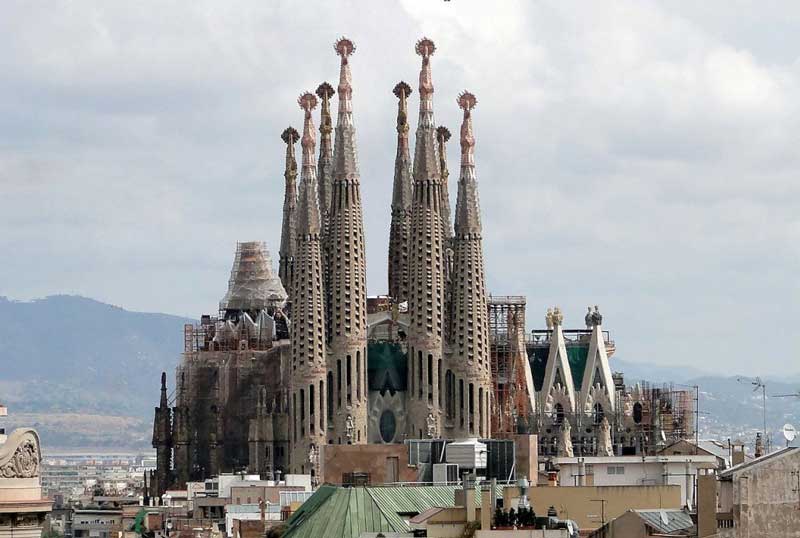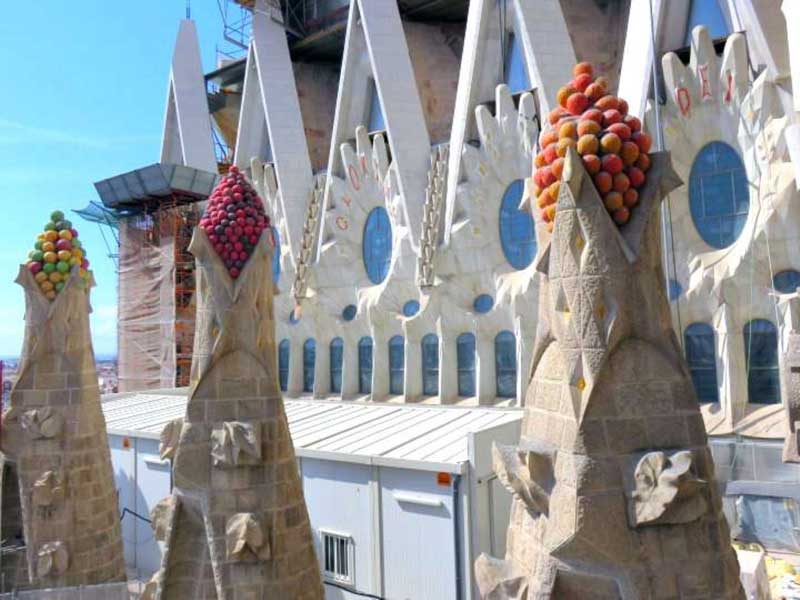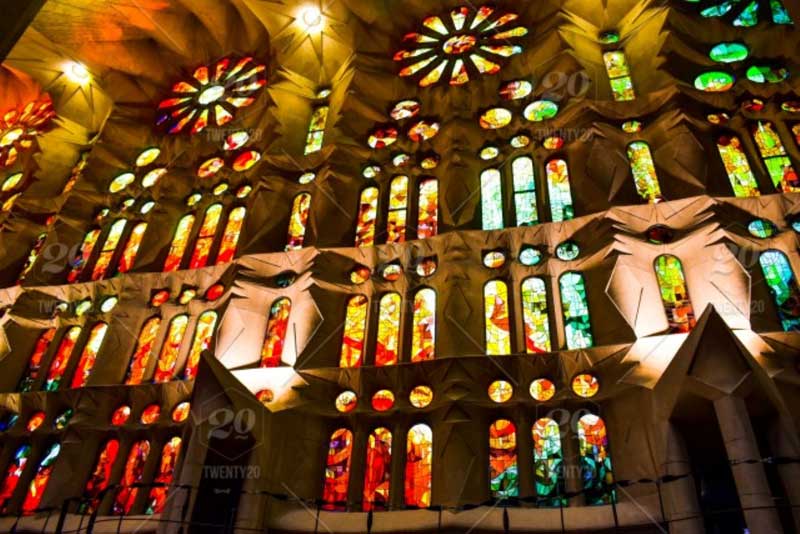
Basilica de la Sagrada Familia or simply Sagrada Familia, officially named Basilica I Temple Expiatori da la Sagrada Familia, is a massive unfinished basilica, located in Barcelona, a city on the coast of northeastern Spain. Long after the construction of the church began on 19 March 1883, it was consecrated and proclaimed as a minor basilica by Pope Benedict XVI on 7 November 2010, before its tentative date of completion by 2026.
It all started in 1872, when after a visit to the Vatican, Josep Maria Bocabella, a bookseller and founder of the Spiritual Association of Devotees of St Joseph, returned to Spain with the vision of constructing a church like the Basilica della Santa Casa in Loreto, Italy.

Josep Maria Bocabella, a Spanish philanthropist and a devout bookseller, envisioned the Basilica of Sagrada Familia and entrusted to materialise his dream project to the reputed architect Francisco de Paula del Villar in 1882. His plans consisted of a three-nave church, complete with blister windows, exterior buttresses and a high needle-like spire, all typical of Gothic architecture. However, as Villar resigned in 1883, the project was entrusted to Antoni Gaudí, a 31-year-old blue-eyed young architect, who completely changed the original design and introduced nature by combining curvilinear Art Nouveau, Catalan Modernism and Spanish Gothic to the design. Gaudí devoted the rest of his life to the project, but when he died and was buried in the crypt in 1926, only less than a quarter of the project was complete and eventually, the Sagrada project was taken over by Domenec Sugranyes, the main disciple of Gaudi.

However, the construction of the Sagrada Familia progressed very slowly, as it was solely dependent on the donations made by visitors and the public.
The work was also interrupted by the onset of the Spanish Civil War, when in July 1936, parts of the unfinished basilica and Gaudi’s workshop, containing his original plans, drawings and models of the building, were destroyed by the Catalan anarchists. It took 16 years of hard work to piece together the fragments of the master model, after which construction resumed with intermittent progress in the 1950s.


Antoni Gaudí’s plan for the basilica included a total of eighteen spires, representing in ascending order of height the Twelve Apostles, the Virgin Mary, the four Evangelists, namely Matthew, Mark, Luke and John and Jesus Christ, the tallest of all. However, as of 2021, only nine spires, corresponding to four apostles at the Nativity façade, four apostles at the Passion façade and the Virgin Mary spire were built. Among the remaining spires, the Evangelists' spires will be surmounted by sculptures of their traditional symbols, namely a winged bull for Saint Luke, a winged man for Saint Matthew, an eagle for Saint John and a winged lion, representing Saint Mark. The central spire of Jesus Christ is to be surmounted by a giant cross with a total height of 566 feet (172.5 m). After the completion of the spires, Sagrada Família will become the tallest church building in the world, 36 feet (11 m) taller than the Ulm Minster in Germany.

Gaudí designed three grand facades for Sagrada Familia, of which the Nativity façade to the east, symbolising the birth of Jesus, was built before the work was temporarily suspended due to the Spanish Civil War. The façade, culminating with four bell towers dedicated to St Matthew, St Jude, St Simon and St Barnabas, has three entries, representing the theological virtues, Charity at the centre, Hope to the left and Faith to the right, while the Tree of Life rises above the door of Jesus in the portico of Charity.
Its four steeples are dedicated to Saint Mathias, Barnabas, Jude the Apostle and Simon the Zealot. Of the other two facades, the Passion façade, facing the setting sun, is intended to portray the sins of man. Carved with harsh straight lines, resembling the bones of a skeleton and supported by six large and inclined columns, the façade is dedicated to the Passion of Christ during his crucifixion. Scenes from the life of Jesus are sculptured on the façade in three levels. While the construction of the Passion façade began in 1954, its steeples were completed in 1976. The construction of the third façade, the Glory façade to the south, depicting various scenes such as Hell and Purgatory with elements like the seven deadly sins and the seven heavenly virtues, began in 2002. After completion, it will be the largest of the three facades, representing the road to God: Death, Final Judgment and Glory. The bell towers of the façade that remain to be built will the dedicated to St Andrew, St Peter and Jacques d’Alpheus.


The lavishly decorated basilica, filled with artistic delights, is planned like a Latin cross with five aisles. While the central nave vaults reach around 148 feet (45 m), the side nave vaults reach about 98 feet (30 m). The transept is equipped with three aisles and the apse is capped by a hyperboloid vault reaching about 246 feet (75 m). Although the columns inside the basilica are on a 25 feet (7.5 m) grid, the columns of the apse, resting on del Villar's foundation, do not adhere to the grid, requiring a section of columns of the ambulatory to transition to the grid, create a horseshoe pattern to the layout of those columns. The columns, made of red porphyry and basalt, are crafted in the shape of tree trunks to make visitors feel like they were deep inside a forest rather than a church. The unique double twisted design of the columns symbolises the saints ascending to heaven and the angels descending to welcome them. Antoni Gaudí intentionally avoided straight lines and angles in the interior of the Sagrada Familia to give it a more natural feel. The four columns in the centre of the church’s transept are dedicated to the Evangelists and their symbols are marked on the lamps on those columns. Those lamps on the columns, depicting a winged man for Matthew, a winged lion for Mark, a winged ox for Luke and an eagle for John, illuminate the interior with rainbows of light after the sun sets.

The remaining columns are dedicated to the twelve apostles, four Catalan bishops, 15 Spanish cities with archbishops and five continents, excluding Antarctica and Australia. There is an intricate illustration of the patron saint of its diocese on each lamp, to bring colour to the church. In addition to the lamps on the columns, the vibrant stained glass windows give the church its other main source of light. The high Altar of the Sagrada Familia, made of a giant block of porphyry from Iran, is located between two columns representing St. Peter and St. Paul.

Sagrada Familia, expected to be finished by 2026, just in time for Antoni Gaudi’s death centenary, is all set to become the church that has the longest time of construction in history with a record time, which could be nearly 150 years. Apart from being the tallest church in the world, the unfinished edifice attracts thousands of tourists and architects from all over the world, boosting the economy of the country.